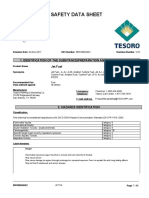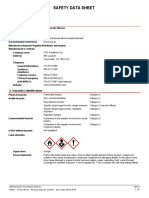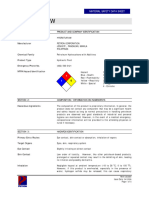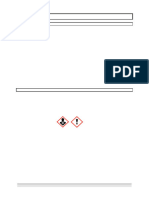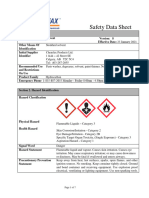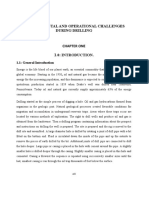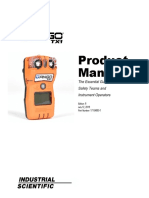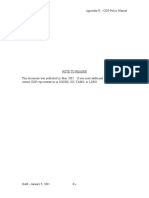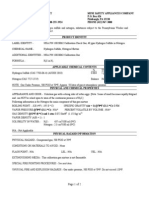Safety Data Sheet: 1. Identification of The Substance/Preparation and of The Company Decant Oil
Safety Data Sheet: 1. Identification of The Substance/Preparation and of The Company Decant Oil
Uploaded by
ZakyAlFatonyCopyright:
Available Formats
Safety Data Sheet: 1. Identification of The Substance/Preparation and of The Company Decant Oil
Safety Data Sheet: 1. Identification of The Substance/Preparation and of The Company Decant Oil
Uploaded by
ZakyAlFatonyOriginal Description:
Original Title
Copyright
Available Formats
Share this document
Did you find this document useful?
Is this content inappropriate?
Copyright:
Available Formats
Safety Data Sheet: 1. Identification of The Substance/Preparation and of The Company Decant Oil
Safety Data Sheet: 1. Identification of The Substance/Preparation and of The Company Decant Oil
Uploaded by
ZakyAlFatonyCopyright:
Available Formats
SAFETY DATA SHEET
Revision Date 14-Feb-2018 SDS Number 888100005143 Revision Number 1.02
1. IDENTIFICATION OF THE SUBSTANCE/PREPARATION AND OF THE COMPANY
Product Name Decant Oil
Synonyms Residual Fuel Oil, Slurry Oil, Slurry Fuel Oil, Catalytic Cracked Clarified Oil, Cat Bottoms,
Catalytic Cracked Decant Oil, FCC Clarified Oil, 3HDS Feed, FZGO, Flash Zone Gas Oil,
HHCGO, Heavy Heavy Coker Gas Oil, HCGO, Heavy Coker Gas Oil, Fractionator Bottoms,
Recycle Oil, APPC700, Carbon Black Oil, RS403
Recommended Use Fuel, Intermediate Stream
Uses advised against All others
Manufacturer Emergency Chemtrec: 1-800-424-9300
Tesoro Refining & Marketing Co. Telephone Tesoro Call Center: 1-877-783-7676
19100 Ridgewood Parkway
San Antonio, TX 78259 E-mail address ProductStewardship@TSOCORP.com
2. HAZARDS IDENTIFICATION
Classification
This chemical is considered hazardous by the 2012 OSHA Hazard Communication Standard (29 CFR 1910.1200)
Flammable liquids Category 3
Acute dermal toxicity Category 4
Carcinogenicity Category 1B
Chronic Aquatic Toxicity Category 3
Label elements
Danger
Flammable liquid and vapor
Harmful in contact with skin
May cause cancer
Harmful to aquatic life with long lasting effects
_____________________________________________________________________________________________
888100005143 Decant Oil Page 1 / 11
Appearance Liquid Physical State @20°C Liquid Odor Petroleum asphalt
Precautionary Statements - Prevention
Obtain special instructions before use
Do not handle until all safety precautions have been read and understood
Wear protective gloves/protective clothing/eye protection/face protection
Keep away from heat/sparks/open flames/hot surfaces. - No smoking
Keep container tightly closed
Ground/or bond container and receiving equipment
Use explosion-proof electrical/ ventilating / lighting / equipment
Use only non-sparking tools
Take precautionary measures against static discharge
Precautionary Statements - Response
IF exposed or concerned: Get medical advice/attention
Call a POISON CENTER or doctor if you feel unwell
IF ON SKIN (or hair): Take off immediately all contaminated clothing. Rinse skin with water/ shower
Wash contaminated clothing before reuse
In case of fire: Use CO2, dry chemical, or foam to extinguish
Precautionary Statements - Storage
Store in a well-ventilated place. Keep cool
Precautionary Statements - Disposal
Dispose of contents/container to an approved waste disposal plant
Hazards not otherwise classified (HNOC)
Not applicable
Other Information
May be harmful if swallowed. Causes mild skin irritation. Toxic to aquatic life.
3. COMPOSITION/INFORMATION ON INGREDIENTS
Chemical Name CAS-No Percent
Clarified oils (petroleum), catalytic cracked; Heavy 64741-62-4 0-100
Fuel oil
Distillates (petroleum), heavy cracked; Heavy Fuel 64741-61-3 0-50
oil
Distillates (petroleum), intermediate catalytic 64741-60-2 0-20
cracked; Cracked gasoil
Sulfur 7704-34-9 0-2
Hydrogen Sulfide 7783-06-4 0-<1
Polycyclic Aromatic Hydrocarbons 130498-29-2 0-<0.2
4. FIRST AID MEASURES
Description of first aid measures
_____________________________________________________________________________________________
888100005143 Decant Oil Page 2 / 11
General advice Show this safety data sheet to the doctor in attendance. Remove from exposure, lie down.
In case of accident or if you feel unwell, seek medical advice immediately. When
symptoms persist or in all cases of doubt, seek medical advice. Never give anything by
mouth to an unconscious person. Take off all contaminated clothing immediately and
thoroughly wash material from skin.
Inhalation Remove from exposure, lie down. If breathing has stopped, give artificial respiration. Get
medical attention immediately. If breathing is difficult, administer oxygen. If symptoms
persist, call a physician.
Eye contact Rinse immediately with plenty of water, also under the eyelids, for at least 15 minutes. Keep
eye wide open while rinsing. Do not rub affected area.
Skin contact Wash off immediately with soap and plenty of water while removing all contaminated
clothes and shoes. If symptoms persist, call a physician.
Ingestion Do NOT induce vomiting. Clean mouth with water and drink afterwards plenty of water.
Never give anything by mouth to an unconscious person. Call a physician.
Self-protection of the first aider Remove all sources of ignition. Ensure that medical personnel are aware of the material(s)
involved, take precautions to protect themselves and prevent spread of contamination. Use
personal protective equipment as required. See section 8 for more information. Wear
personal protective clothing (see section 8).
Most important symptoms and effects, both acute and delayed
Indication of any immediate medical attention and special treatment needed
Note to physicians Treat symptomatically.
5. FIRE-FIGHTING MEASURES
Small Fire Any extinguisher suitable for Class B fires, dry chemical, CO2, foam (AFFF/ATC), or water
spray can be used.
Large Fire Water spray, fog or alcohol-resistant foam. CAUTION: Use of water spray when fighting fire
may be inefficient. Cool containers with flooding quantities of water until well after fire is out.
Unsuitable extinguishing media CAUTION: Use of water spray when fighting fire may be inefficient.
Specific hazards arising from the Risk of ignition. Keep product and empty container away from heat and sources of ignition.
chemical In the event of fire, cool tanks with water spray. Fire residues and contaminated fire
extinguishing water must be disposed of in accordance with local regulations.
Hazardous combustion products Smoke, CO, and other products of incomplete combustion.
Explosion data
Sensitivity to Mechanical Impact None.
Sensitivity to Static Discharge Yes.
Special protective equipment for Firefighters should wear self-contained breathing apparatus and full firefighting turnout
fire-fighters gear. For massive fire, use unmanned hose holders or monitor nozzles; if this is impossible
withdraw from area and let fire burn.
Further information ALWAYS stay away from tanks engulfed in fire. Fight fire from maximum distance or use
unmanned hose holders or monitor nozzles. Withdraw immediately in case of rising sound
from venting safety devices or discoloration of tank. Do not direct water at source of leak or
safety devices; icing may occur. Cool containers with flooding quantities of water until well
after fire is out. Do not allow run-off from fire-fighting to enter drains or water courses.
NFPA Health hazards 0 Flammability 2 Stability 0 Physical and chemical
properties -
_____________________________________________________________________________________________
888100005143 Decant Oil Page 3 / 11
6. ACCIDENTAL RELEASE MEASURES
Personal precautions, protective equipment and emergency procedures
Personal precautions Evacuate personnel to safe areas. Use personal protective equipment as required. See
section 8 for more information. Avoid contact with skin, eyes or clothing. Ensure adequate
ventilation. Keep people away from and upwind of spill/leak. ELIMINATE all ignition sources
(no smoking, flares, sparks or flames in immediate area). Pay attention to flashback. Take
precautionary measures against static discharges. All equipment used when handling the
product must be grounded. Do not touch or walk through spilled material.
Other Information Ventilate the area. Refer to protective measures listed in Sections 7 and 8.
Environmental precautions
Environmental precautions Refer to protective measures listed in Sections 7 and 8. Prevent further leakage or spillage
if safe to do so. Prevent product from entering drains.
Methods and material for containment and cleaning up
Methods for containment Stop leak if you can do it without risk. Do not touch or walk through spilled material. A vapor
suppressing foam may be used to reduce vapors. Dike far ahead of spill to collect runoff
water. Keep out of drains, sewers, ditches and waterways. Absorb with earth, sand or other
non-combustible material and transfer to containers for later disposal.
Methods for cleaning up Take precautionary measures against static discharges. Dam up. Soak up with inert
absorbent material. Pick up and transfer to properly labeled containers.
Prevention of secondary hazards Clean contaminated objects and areas thoroughly observing environmental regulations.
7. HANDLING AND STORAGE
Precautions for safe handling
Advice on safe handling Use personal protection equipment. Avoid contact with skin and eyes. Avoid breathing
vapors or mists. Keep away from heat/sparks/open flames/hot surfaces. - No smoking. Use
grounding and bonding connection when transferring this material to prevent static
discharge, fire or explosion. Use with local exhaust ventilation. Use spark-proof tools and
explosion-proof equipment. Keep in an area equipped with sprinklers. Use according to
package label instructions. Handle in accordance with good industrial hygiene and safety
practice. Avoid contact with skin, eyes or clothing.
Conditions for safe storage, including any incompatibilities
Storage Conditions Keep containers tightly closed in a dry, cool and well-ventilated place. Keep away from
heat, sparks, flame and other sources of ignition (i.e., pilot lights, electric motors and static
electricity). Keep in properly labeled containers. Do not store near combustible materials.
Keep in an area equipped with sprinklers. Store in accordance with the particular national
regulations. Store in accordance with local regulations. Store locked up.
8. EXPOSURE CONTROLS/PERSONAL PROTECTION
Chemical Name ACGIH TLV OSHA PEL
Hydrogen Sulfide STEL: 5 ppm
(vacated) TWA: 10 ppm
7783-06-4 (vacated) TWA: 14 mg/m3
TWA: 1 ppm
(vacated) STEL: 15 ppm
(vacated) STEL: 21 mg/m3
Ceiling: 20 ppm
NOTE:Li
mit
sshownf
orgui
danceonl
y.Foraddi
ti
onali
nfor
mat
ion,OSHA’
s1989ai
rcont
ami
nantsst andar dex posureli
mit
s
_____________________________________________________________________________________________
888100005143 Decant Oil Page 4 / 11
provided even though the limits were vacated in 1992. State, local or other agencies or advisory groups may have established
more stringent limits. Follow applicable regulations.
Appropriate engineering controls
Engineering controls Showers
Eyewash stations
Ventilation systems.
Individual protection measures, such as personal protective equipment
Eye/face protection Tight sealing safety goggles.
Hand Protection Wear suitable gloves. Impervious gloves.
Skin and body protection Wear suitable protective clothing. Long sleeved clothing. Chemical resistant apron.
Antistatic boots.
Respiratory protection When workers are facing concentrations above the exposure limit they must use
appropriate certified respirators. Use a NIOSH approved respirator when there is a potential
for airborne concentrations to exceed occupational exposure limits. Refer to OSHA 29 CFR
1910.134, ANSI Z88.2, NIOSH Respirator Decision Logic, and the respirator manufacturer
for additional guidance on respiratory protection selection. A Self-Contained Breathing
Apparatus (SCBA) should be used for fire fighting. Use a NIOSH approved
positive-pressure supplied air respirator if there is a potential for uncontrolled release,
exposure levels are unknown, in oxygen deficient (less than 19.5% oxygen), or any other
circumstance where an air-purifying respirator may not provide adequate protection.
General hygiene considerations Do not eat, drink or smoke when using this product. Contaminated work clothing should not
be allowed out of the workplace. Regular cleaning of equipment, work area and clothing is
recommended. Wash hands before breaks and immediately after handling the product.
Avoid contact with skin, eyes or clothing. Wear suitable gloves and eye/face protection.
9. PHYSICAL AND CHEMICAL PROPERTIES
Information on basic physical and chemical properties
Physical State @20°C Liquid
Appearance Liquid
Odor Petroleum asphalt
Color Dark green to brown or black
Odor threshold No data available
Property Values Remar ks •Met
hod
pH Not applicable
Melting point / freezing point 32 °C / 90 °F
Boiling range 154 - 154-372 °C
Flash point 60 °C / 140 °F Minimum
Evaporation rate No data available
Flammability (solid, gas) Flammable vapor may be released by
heated liquid
Flammability Limit in Air %
Upper flammability limit: No data available
Lower flammability limit: No data available
Vapor pressure 210
Vapor density >5
Relative density >0.9 1.2
Water solubility 6 to 1400 mg/L at 25°C
Solubility in other solvents No data available
Partition coefficient 3.4 to 5
Autoignition temperature >176 °C / >350 °F
Decomposition temperature No data available
_____________________________________________________________________________________________
888100005143 Decant Oil Page 5 / 11
Kinematic viscosity >300 cSt
Dynamic viscosity No data available
Explosive properties No data available
Oxidizing properties No data available
Minimum Ignition Energy (mJ) No data available
K st (bar.m/s) No data available
Softening point No data available
VOC Content (%) No data available
Density No data available
Bulk density Not applicable
Conductivity Hydrocarbon liquids without static dissipater additive may have conductivity below 1
picoSiemens per meter (pS/m). The highest electro-static ignition risks are associated with
”ult
ra-lowconduct i
vi
ti
es”bel ow5pS/ m.SeeSect ion7f orsour cesofi nformat i
onondef ining
safe loading and handling procedures for low conductivity products. Note that conductivity
can be reduced by environmental factors such as a decrease in temperature
10. STABILITY AND REACTIVITY
Reactivity This product is non-reactive under normal conditions.
Chemical stability Stable under recommended storage conditions.
Possibility of hazardous reactions None under normal processing.
Conditions to avoid Heat, flames and sparks.
Incompatible materials Oxidizing or reducing agents. Acids. Alkali.
Hazardous decomposition products None under normal use conditions.
11. TOXICOLOGICAL INFORMATION
Information on likely routes of exposure
Inhalation May cause central nervous system depression with nausea, headache, dizziness, vomiting,
and incoordination. The burning of any hydrocarbon as a fuel in an area without adequate
ventilation may result in hazardous levels combustion products, including carbon monoxide
(CO), and inadequate oxygen levels, which may cause unconsciousness, suffocation, and
death. Hydrogen sulfide can cause respiratory paralysis and death, depending on
concentration and duration of exposure. The "rotten egg" odor of hydrogen sulfide is not a
reliable indicator of exposure, since olfactory fatigue (loss of smell) will occur.
Eye contact Contact with product at elevated temperatures can result in thermal burns. Liquid splashed
in the eyes may cause irritation and reversible damage.
Skin contact May be absorbed through the skin in harmful amounts. Harmful in contact with skin.
Ingestion Ingestion may cause gastrointestinal irritation, nausea, vomiting and diarrhea. May be
harmful if swallowed and enters airways.
Information on toxicological effects
Symptoms Symptoms of overexposure may be headache, dizziness, tiredness, nausea and vomiting.
Numerical measures of toxicity
Acute toxicity
The following values are calculated based on chapter 3.1 of the GHS document .
ATEmix (oral) 2,395.00 mg/kg
ATEmix (dermal) 1,164.00 mg/kg
ATEmix (inhalation-gas) 35,512.76 mg/l
_____________________________________________________________________________________________
888100005143 Decant Oil Page 6 / 11
ATEmix (inhalation-dust/mist) 5.01 mg/l
Chemical Name Oral LD50 LD50/dermal/rat - NO UNITS Inhalation LC50
(Wizards mg/kg)
Clarified oils (petroleum), 4320 - 5270 mg/kg ( Rat ) > 2000 mg/kg ( Rabbit ) > 3700 mg/m3 ( Rat ) 4 h
catalytic cracked; Heavy Fuel oil
64741-62-4
Distillates (petroleum), heavy = 4320 mg/kg ( Rat ) > 2000 mg/kg ( Rabbit ) -
cracked; Heavy Fuel oil
64741-61-3
Distillates (petroleum), = 3200 mg/kg ( Rat ) > 2000 mg/kg ( Rabbit ) = 4.65 mg/L ( Rat ) 4 h
intermediate catalytic cracked;
Cracked gasoil
64741-60-2
Sulfur > 3000 mg/kg ( Rat ) > 2000 mg/kg ( Rabbit ) > 9.23 mg/L ( Rat ) 4 h
7704-34-9
Hydrogen Sulfide - - = 700 mg/m3 ( Rat ) 4 h
7783-06-4
Delayed and immediate effects as well as chronic effects from short and long-term exposure
Chemical Name
Distillates (petroleum), heavy Heavy Fuel Oils (HFO) may be fatal if they are swallowed and enter the airway. If inhaled,
cracked; Heavy Fuel oil short-term overexposure can cause immediate unconsciousness and death. In animal
studies, substances in the Heavy Fuel Oil Category demonstrate low oral and dermal
toxicity, minimal eye irritation, minimal to moderate skin irritation with single exposures and
are not skin sensitizers. The other mammalian health effects of HFOs are dependent on
their content of polycyclic aromatic compounds (PAC). PAC content and aromatic ring class
distribution profiles are determined by crude oil stock and the nature and severity of
processing. Repeated dose studies indicate that dermal toxicity induced by different HFO
streams affected essentially the same organ systems (liver, spleen, thymus and bone
marrow). Most studies from these streams did not report adverse effects on fertility, but
some streams caused fetal toxicity. Genetic toxicity studies in vitro demonstrate that many
streams in the heavy fuel oil category are gene mutagens. The carcinogenicity of individual
petroleum streams varies due to factors such as source and processing; IARC and ECHA
C&L Inventory reports individually on the carcinogenicity of these substances.
Distillates (petroleum), intermediate Gas oils and distillate fuels may be fatal if they are swallowed and enter the airway. If
catalytic cracked; Cracked gasoil inhaled, short-term overexposure can cause disorientation, nausea, vomiting, signs of
central nervous system effects such as headache or disorientation, immediate
unconsciousness and death. In animal studies, gas oil streams and distillate fuels
demonstrated minimal acute toxicity by the oral, dermal and inhalation routes, minimal eye
irritation, moderate to severe skin irritation with 24 hours exposure, and no dermal
sensitization. Generally, results suggest that the degree of toxicity is associated with the
concentrations and ring distributions of aromatic constituents in the fuels. When dermal
exposures last 24 hours or longer, moderate to severe skin irritation, but not sensitization,
has been reported in animal studies. Repeated dermal exposures have been reported to
cause systemic effects in animals, including changes in liver and thymus weight and blood
chemistry. Some gas oil streams and distillate fuels can cause gene mutations in studies
using bacteria and animal tissue. Results of developmental studies with gas oils
demonstrate that some gas oils induce developmental effects and others do not. Effects
observed include reduced litter size through resorptions, lower body weights, and fetal
malformations were reported for 2 members of the category. Studies in animals indicate
that gas oils and distillate fuels are potential skin carcinogens after repeated skin
application, but are not associated with tumors in other parts of the body (systemic tumors).
The carcinogenicity of individual petroleum streams varies due to factors such as source
and processing; IARC and ECHA C&L Inventory reports individually on the carcinogenicity
of these substances.
Hydrogen Sulfide Hydrogen Sulfide may be fatal if inhaled. The nervous system and respiratory tract are the
main targets of hydrogen sulfide toxicity. Short term (acute) overexposure may cause
irritation to the eyes, nose or throat. At high enough levels, effects on the nervous system
_____________________________________________________________________________________________
888100005143 Decant Oil Page 7 / 11
include headaches, poor concentration, poor memory, unconsciousness, and death.
Hydrogen sulfide has a strong odor that is characteristic of rotten eggs; however, the odor
is not a reliable warning property as olfactory fatigue occurs at high levels. Respiratory
distress or arrest can occur at high concentrations. Direct contact of the liquid with skin can
cause frostbite; contact with the eyes can cause redness or severe burns. Cardiovascular
effects have also been observed. NIOSH has determined that 100 ppm is immediately
dangerous to life and health.
Health hazard and classification information
Skin Corrosion/Irritation Category No information available.
Serious eye damage/eye irritation No information available.
No information available.
Germ cell mutagenicity No information available.
Carcinogenicity Classification based on data available for ingredients. Contains a known or suspected
carcinogen.
The table below indicates whether each agency has listed any ingredient as a carcinogen.
Reproductive toxicity No information available.
Target Organ Systemic Toxicant - No information available.
Single Exposure
Target Organ Systemic Toxicant - No information available.
Repeated Exposure
Target organ effects Respiratory system, Eyes, Central nervous system.
Aspiration hazard No information available.
12. ECOLOGICAL INFORMATION
Additional Ecological Information Release of this product should be prevented from contaminating soil and water and from
entering drainage and sewer systems. U.S.A. regulations require reporting spills of this
material that could reach any surface waters. The toll free number to the U.S. Coast Guard
National Response Center is (800) 424-8802
Ecotoxicity Harmful to aquatic life with long lasting effects.
Chemical Name Algae/aquatic plants Fish Toxicity to Crustacea
microorganisms
Clarified oils (petroleum), - 48: 96 h Brachydanio - -
catalytic cracked; Heavy rerio mg/L LC50
Fuel oil semi-static
64741-62-4
Distillates (petroleum), - 48: 96 h Brachydanio - -
heavy cracked; Heavy rerio mg/L LC50
Fuel oil semi-static
64741-61-3
Distillates (petroleum), - 7.3: 96 h Brachydanio - -
intermediate catalytic rerio mg/L LC50
cracked; Cracked gasoil semi-static
64741-60-2
Sulfur - 14: 96 h Lepomis - -
7704-34-9 macrochirus mg/L LC50
static 866: 96 h
Brachydanio rerio mg/L
_____________________________________________________________________________________________
888100005143 Decant Oil Page 8 / 11
LC50 static 180: 96 h
Oncorhynchus mykiss
mg/L LC50 static
Hydrogen Sulfide - 0.016: 96 h Pimephales - 0.022: 96 h Gammarus
7783-06-4 promelas mg/L LC50 pseudolimnaeus mg/L
flow-through 0.0448: 96 h LC50
Lepomis macrochirus
mg/L LC50 flow-through
Persistence and degradability No information available.
Bioaccumulation There is no data for this product.
Component Information
Chemical Name Partition coefficient
Hydrogen Sulfide 0.45
7783-06-4
Other adverse effects No information available.
13. DISPOSAL CONSIDERATIONS
Waste treatment methods
Waste from residues/unused Should not be released into the environment. Dispose of in accordance with local
products regulations. Dispose of waste in accordance with environmental legislation.
Contaminated packaging Empty containers pose a potential fire and explosion hazard. Do not cut, puncture of weld
containers.
US EPA Waste Number D001, U135
Chemical Name RCRA RCRA - Basis for Listing RCRA - D Series Wastes RCRA - U Series Wastes
Hydrogen Sulfide U135 - - U135
7783-06-4
Polycyclic Aromatic - Included in waste stream: - -
Hydrocarbons K022
130498-29-2
14. TRANSPORT INFORMATION
DOT Not regulated if shipped under 140F (60C).
UN/ID no NA 1993
Proper Shipping Name COMBUSTIBLE LIQUID, N.O.S.* (if shipped at temperatures >140F(60C))
Hazard Class Comb liq
Packing group III
TDG Not regulated if shipped below 140F (60C).
UN/ID no 3256 if shipped above 140F (60C)
Proper Shipping Name Elevated temperature liquid, flammable (if shipped above 140F (60C))
Hazard Class 9
Subsidiary class III
Description Clarified oils (petroleum), catalytic cracked; fuel oil
MEX Not regulated
IATA UN3257 if shipped at temperature above 212F.
_____________________________________________________________________________________________
888100005143 Decant Oil Page 9 / 11
UN/ID no UN9
Packing group III
Special Provisions Not permitted for transport
IMDG Not regulated
UN/ID no UN 3257 if shipped at temperature above 212F
Proper Shipping Name Elevated temperature solid, n.o.s. Clarified oils (petroleum), catalytic cracked; fuel oil
Hazard Class 9
Packing group III
EmS No. F-A S-P
15. REGULATORY INFORMATION
International Inventories
TSCA Not Listed
DSL/NDSL Not Listed
ENCS Not Listed
IECSC Not Listed
KECL Not Listed
PICCS Not Listed
AICS Not Listed
Legend:
TSCA - United States Toxic Substances Control Act Section 8(b) Inventory
DSL/NDSL - Canadian Domestic Substances List/Non-Domestic Substances List
ENCS - Japan Existing and New Chemical Substances
IECSC - China Inventory of Existing Chemical Substances
KECL - Korean Existing and Evaluated Chemical Substances
PICCS - Philippines Inventory of Chemicals and Chemical Substances
AICS - Australian Inventory of Chemical Substances
US Federal Regulations
SARA 313
Section 313 of Title III of the Superfund Amendments and Reauthorization Act of 1986 (SARA). This product does not contain any
chemicals which are subject to the reporting requirements of the Act and Title 40 of the Code of Federal Regulations, Part 372.
SARA 311/312 Hazard Categories
Acute health hazard Yes
Chronic Health Hazard Yes
Fire hazard Yes
Sudden release of pressure hazard No
Reactive Hazard No
CWA (Clean Water Act)
This product contains the following substances which are regulated pollutants pursuant to the Clean Water Act (40 CFR 122.21
and 40 CFR 122.42).
Chemical Name CWA - Reportable CWA - Toxic Pollutants CWA - Priority Pollutants CWA - Hazardous
Quantities Substances
Hydrogen Sulfide 100 lb - - X
7783-06-4
Polycyclic Aromatic - X - -
Hydrocarbons
130498-29-2
CERCLA
TheCERCLAdef i
niti
onofhazar doussubst ancescont ainsa“ petr
oleum ex cl
usi on”clausewhi chex empt scrudeoil,f
ract
ionsof
crude oil, and products (both finished and intermediate) from the crude oil refining process and any indigenous components of such
from the CERCLA Section 103 reporting requirements. However, other federal reporting requirements, including SARA Section
304, as well as the Clean Water Act may still apply.
_____________________________________________________________________________________________
888100005143 Decant Oil Page 10 / 11
US State Regulations
California Proposition 65
This product does not contain any Proposition 65 chemicals.
U.S. State Right-to-Know Regulations
US State Regulations
Chemical Name New Jersey Massachusetts Pennsylvania
Sulfur X X X
7704-34-9
Hydrogen Sulfide X X X
7783-06-4
16. OTHER INFORMATION, INCLUDING DATE OF PREPARATION OF THE LAST REVISION
Revision Date 14-Feb-2018
Revision Note No information available.
Disclaimer
Tesoro Companies, Inc. (Tesoro) provides the information on this Safety Data Sheet (SDS) in order to meet its obligations
under 29 CFR 1910.1200, and does not hereby make any guarantee of product specifications or suitability for any
par ti
cularpur pose.Tesor odoesnotassumeanyl i
abi l
ityar i
singoutoft heuseofTesor o’
spr oductort heuseof
information provided on this SDS. The end user of the product has the responsibility for evaluating the adequacy of the
data under the conditions of use, determining the safety, toxicity and suitability of the product under these conditions,
and obtaining additional or clarifying information where uncertainty exists. No guarantee expressed or implied is made as
to the effects of such use, the results to be obtained, or the safety and toxicity of the product in any specific application.
Furthermore, the information herein is not represented as absolutely complete, since it is not practicable to provide all
relevant information in the format of this document, since additional information may be necessary under exceptional
conditions of use, and since Tesoro prepared this SDS based on information available on the date of its publication.
96, 1088, 2780
End of Safety Data Sheet
_____________________________________________________________________________________________
888100005143 Decant Oil Page 11 / 11
You might also like
- Fire Water ProtectionDocument68 pagesFire Water ProtectionZakyAlFatony100% (1)
- Iron Sulfide ScaleDocument8 pagesIron Sulfide ScaleAnonymous aIuHKoKZj100% (1)
- Light Cycle Oil LcoDocument13 pagesLight Cycle Oil LcoPRASENJIT CHAKRABORTYNo ratings yet
- Safety Data Sheet: 1. Identification of The Substance/Preparation and of The Company Gas Oil, VirginDocument11 pagesSafety Data Sheet: 1. Identification of The Substance/Preparation and of The Company Gas Oil, VirginHassan FaheemNo ratings yet
- Safety Data Sheet: 1. IdentificationDocument10 pagesSafety Data Sheet: 1. IdentificationAnthony Lloyd WattonNo ratings yet
- Denatured Fuel Ethanol SDSDocument10 pagesDenatured Fuel Ethanol SDSMartin HislopNo ratings yet
- CRC Gdi Ivd Intake Valve & Turbo Cleaner 1003763eDocument10 pagesCRC Gdi Ivd Intake Valve & Turbo Cleaner 1003763eAsadNo ratings yet
- Safety Data Sheet: 1. Identification of The Substance/Preparation and of The Company Jet FuelDocument14 pagesSafety Data Sheet: 1. Identification of The Substance/Preparation and of The Company Jet FuelHassan FaheemNo ratings yet
- Safety Data Seeet: 1. IdentificationDocument11 pagesSafety Data Seeet: 1. Identificationحسين النوفليNo ratings yet
- SGP101062Document9 pagesSGP101062Omri AmayaNo ratings yet
- Hydrotur R: Material Safety Data SheetDocument6 pagesHydrotur R: Material Safety Data SheetKattie ValerioNo ratings yet
- MSDS White GreaseDocument10 pagesMSDS White GreaseAndini Nur Paujiah100% (1)
- Brake Parts Cleaner WES W7340 PDFDocument11 pagesBrake Parts Cleaner WES W7340 PDFYoutube For EducationNo ratings yet
- Safety Data Sheet: 1. Identification of The Substance/Preparation and of The Company Sulfur, MoltenDocument9 pagesSafety Data Sheet: 1. Identification of The Substance/Preparation and of The Company Sulfur, MoltenGerome EugenioNo ratings yet
- Diesel Addidative - ABRO Diesel Injector Cleaner DL-502Document12 pagesDiesel Addidative - ABRO Diesel Injector Cleaner DL-502Pankaj RanjanNo ratings yet
- CHAMPION X - CORR22228ADocument10 pagesCHAMPION X - CORR22228AMolybdnum ChannelNo ratings yet
- MsdsDocument9 pagesMsdsCong khong tienNo ratings yet
- SDS Alcohol 94 - Rhum 95 - Alcohol 96Document13 pagesSDS Alcohol 94 - Rhum 95 - Alcohol 96mhsjmfernandesNo ratings yet
- SDS Petromar HF 1040Document6 pagesSDS Petromar HF 1040Benny Bryle SagunNo ratings yet
- Inhibidor de CorrosiónDocument13 pagesInhibidor de CorrosiónJosé Eduardo Narváez CampechanoNo ratings yet
- Safety Data Sheet: 1. IdentificationDocument9 pagesSafety Data Sheet: 1. IdentificationStephanie RamirezNo ratings yet
- SDS CRC Coil CleanerDocument10 pagesSDS CRC Coil CleanerrudiNo ratings yet
- Msds CRC 02018Document9 pagesMsds CRC 02018ReginaldNo ratings yet
- Safety Data Sheet: 1. IdentificationDocument10 pagesSafety Data Sheet: 1. Identificationuuuujang12No ratings yet
- Mictrans B Ghs Msds e 4Document7 pagesMictrans B Ghs Msds e 4arie611No ratings yet
- Cyclo White GreaseDocument10 pagesCyclo White GreasevivekNo ratings yet
- Croc Bloc HD Insect RepellantDocument8 pagesCroc Bloc HD Insect RepellantPubcrawlNo ratings yet
- Pure Guard High Temp EP Grease US - SDS Rev 3Document8 pagesPure Guard High Temp EP Grease US - SDS Rev 3VARGASNo ratings yet
- Corr21334a Sds Usa (GHS) EnglishDocument10 pagesCorr21334a Sds Usa (GHS) EnglishJosé Eduardo Narváez CampechanoNo ratings yet
- 1 SDS GHSDocument5 pages1 SDS GHSJordanNo ratings yet
- Safety Data Sheet: Section 1: Product and Company IdentificationDocument12 pagesSafety Data Sheet: Section 1: Product and Company IdentificationBranden StricklandNo ratings yet
- MSDS Contak Cleaner CRCDocument9 pagesMSDS Contak Cleaner CRCsuryaNo ratings yet
- SW 945Document10 pagesSW 945sintaNo ratings yet
- Sds Nalco Na 2019 1129 Nalco 71d5 Plus OutputDocument10 pagesSds Nalco Na 2019 1129 Nalco 71d5 Plus Outputchemcm01No ratings yet
- MSDS Vooki Hand Sanitizer MSDS PDFDocument9 pagesMSDS Vooki Hand Sanitizer MSDS PDFarun100% (2)
- Material Safety Data Sheet (MSDS) Sodium Lauryl Ether Sulfate (SLES)Document11 pagesMaterial Safety Data Sheet (MSDS) Sodium Lauryl Ether Sulfate (SLES)Mohit JagtapNo ratings yet
- 125 Anfo - AmexDocument5 pages125 Anfo - AmexJoyas MicaNo ratings yet
- Lectra Clean® II Non-Chlorinated Heavy Duty Degreaser - Jul2014 - EnglishDocument8 pagesLectra Clean® II Non-Chlorinated Heavy Duty Degreaser - Jul2014 - EnglishFabiano LimaNo ratings yet
- MTF SDS Cooling Water MaintenanceDocument42 pagesMTF SDS Cooling Water Maintenancechemcm01No ratings yet
- Alvania EP GreaseDocument5 pagesAlvania EP Greasemingyu parkNo ratings yet
- Hoja de Seguridad - Aceite DielectricoDocument8 pagesHoja de Seguridad - Aceite DielectricoBELTCO CONVEYOR SYSTEM SOLUTIONSNo ratings yet
- CRC Dry Moly LubeDocument10 pagesCRC Dry Moly LubeFakhrudin HalimNo ratings yet
- Trans X SDSDocument12 pagesTrans X SDSNathanNo ratings yet
- Safety Data Sheet: 1. IdentificationDocument13 pagesSafety Data Sheet: 1. IdentificationzealbalaNo ratings yet
- Marvel Mystery Oil MSDSDocument8 pagesMarvel Mystery Oil MSDSSkySupplyUSANo ratings yet
- Sds - Rain Shine AzulDocument10 pagesSds - Rain Shine AzulVictor Rodriguez SotoNo ratings yet
- MSDS Particulas MagneticasDocument8 pagesMSDS Particulas MagneticasCarmen Rosa Montes MarcosNo ratings yet
- Castrol CRB TurbomaxDocument10 pagesCastrol CRB Turbomaxzeta10151015No ratings yet
- Lps 1 Grease Less LubricantDocument8 pagesLps 1 Grease Less LubricantTariqNo ratings yet
- SDS-221 Lectra MotiveDocument9 pagesSDS-221 Lectra MotiveGenesis Carolina Castañeda VenturaNo ratings yet
- Solvent SDS Version 8 2021Document7 pagesSolvent SDS Version 8 2021johanbesarNo ratings yet
- SDS-Petron-Rev-X-Multigrade-HD4X-SAE-15W-40-rev-3Document5 pagesSDS-Petron-Rev-X-Multigrade-HD4X-SAE-15W-40-rev-3wtriconNo ratings yet
- Safety Data Sheet: 1. IdentificationDocument5 pagesSafety Data Sheet: 1. IdentificationEmil LlonaNo ratings yet
- SDS Petron Blaze 100 Euro 6Document7 pagesSDS Petron Blaze 100 Euro 6patrickhenrieemasNo ratings yet
- Triethylamine HPLC 100MLDocument9 pagesTriethylamine HPLC 100MLK naveen reddyNo ratings yet
- Brake Parts Cleaner WES W7341 PDFDocument11 pagesBrake Parts Cleaner WES W7341 PDFYoutube For EducationNo ratings yet
- SDS SampleDocument8 pagesSDS SampleIshan TrivediNo ratings yet
- Raw 01 Rain-RShineBluePVCCement SDS 001Document10 pagesRaw 01 Rain-RShineBluePVCCement SDS 001Matt Mayo SanchezNo ratings yet
- Safety Data Sheet: 1. IdentificationDocument9 pagesSafety Data Sheet: 1. IdentificationindeskeyNo ratings yet
- After a Disaster - Information to Help You and Your Family RecoverFrom EverandAfter a Disaster - Information to Help You and Your Family RecoverNo ratings yet
- Safe Chart Kinanti Field Rev 0Document2 pagesSafe Chart Kinanti Field Rev 0ZakyAlFatonyNo ratings yet
- FT XS 1, DB ViewDocument6 pagesFT XS 1, DB ViewZakyAlFatonyNo ratings yet
- Pump Calculation - HydraulicDocument42 pagesPump Calculation - HydraulicZakyAlFatonyNo ratings yet
- FT 00.raw: 2theta (Coupled Twotheta/Theta) WL 1.54060Document3 pagesFT 00.raw: 2theta (Coupled Twotheta/Theta) WL 1.54060ZakyAlFatonyNo ratings yet
- FT 01, DB ViewDocument6 pagesFT 01, DB ViewZakyAlFatonyNo ratings yet
- James J. Carberry - Chemical and Catalytic Reaction Engineering (2001, Dover Publications)Document334 pagesJames J. Carberry - Chemical and Catalytic Reaction Engineering (2001, Dover Publications)ZakyAlFatonyNo ratings yet
- FT 00, DB ViewDocument6 pagesFT 00, DB ViewZakyAlFatonyNo ratings yet
- Catalyst Increases The Rate of ReactionDocument2 pagesCatalyst Increases The Rate of ReactionZakyAlFatonyNo ratings yet
- Daftar PustakaDocument9 pagesDaftar PustakaZakyAlFatonyNo ratings yet
- FT X0, DB ViewDocument6 pagesFT X0, DB ViewZakyAlFatonyNo ratings yet
- Steam Tables: Saturated Steam: TEMPERATURE TableDocument16 pagesSteam Tables: Saturated Steam: TEMPERATURE TableZakyAlFatonyNo ratings yet
- Perhitungan Friction Head Atau Friction LoosesDocument2 pagesPerhitungan Friction Head Atau Friction LoosesZakyAlFatonyNo ratings yet
- Zaky Al-FatonyDocument16 pagesZaky Al-FatonyZakyAlFatonyNo ratings yet
- Fischer-Tropsch Synthesis For Greener Fuel Oil Production: Pertamina UniversityDocument14 pagesFischer-Tropsch Synthesis For Greener Fuel Oil Production: Pertamina UniversityZakyAlFatonyNo ratings yet
- Application of Computational Chemistry Method To Study The Antioxidant Activity of CurcuminDocument12 pagesApplication of Computational Chemistry Method To Study The Antioxidant Activity of CurcuminZakyAlFatonyNo ratings yet
- Zaky Al-Fatony Department of Chemistry, Faculty of Mathematics and Natural Sciences, Gadjah Mada UniversityDocument1 pageZaky Al-Fatony Department of Chemistry, Faculty of Mathematics and Natural Sciences, Gadjah Mada UniversityZakyAlFatonyNo ratings yet
- Application of Computational Chemistry Method To Study The Relative Antioxidant Efficiency of A Large Series of CarotenoidsDocument15 pagesApplication of Computational Chemistry Method To Study The Relative Antioxidant Efficiency of A Large Series of CarotenoidsZakyAlFatonyNo ratings yet
- K Factor or Watson FactorDocument6 pagesK Factor or Watson FactorZakyAlFatonyNo ratings yet
- AJChE - Zaky Al Fatony - Final ProofingDocument12 pagesAJChE - Zaky Al Fatony - Final ProofingZakyAlFatonyNo ratings yet
- Chapter 3Document165 pagesChapter 3Sofonyas KidaneweldNo ratings yet
- H2S Scavenger Rev.01Document62 pagesH2S Scavenger Rev.01Youcef Chorfa100% (2)
- Chevron Richmond Refinery Site-Safety-PlanDocument121 pagesChevron Richmond Refinery Site-Safety-Plankanakarao1No ratings yet
- Environmental Challenges During DrillingDocument46 pagesEnvironmental Challenges During Drillingrishibarathi100% (1)
- H2S Monitor Manual - Tango TX1Document50 pagesH2S Monitor Manual - Tango TX1MattNo ratings yet
- POE City Owners Manual SXT 2011Document16 pagesPOE City Owners Manual SXT 2011vaglohrdNo ratings yet
- MSDS H2S English - IndoDocument2 pagesMSDS H2S English - IndoArdiNo ratings yet
- Sulfur DegassingDocument15 pagesSulfur DegassingAbdullahNo ratings yet
- Drilling Fluid Contamination and Treatment Drilling Fluid Contamination and TreatmentDocument77 pagesDrilling Fluid Contamination and Treatment Drilling Fluid Contamination and Treatmentahmed otmanNo ratings yet
- Sample Pages Guidelines For The Materials Selection and Corrosion Management of Downhole Production and Injection Well EquipmentDocument10 pagesSample Pages Guidelines For The Materials Selection and Corrosion Management of Downhole Production and Injection Well EquipmentMasiNo ratings yet
- Fixed Bed AbsorbentsDocument8 pagesFixed Bed AbsorbentsArash AbbasiNo ratings yet
- Case Histories of Amine Plant Equipment Corrosion Problems - Part 2Document4 pagesCase Histories of Amine Plant Equipment Corrosion Problems - Part 2jdgh1986No ratings yet
- Level 3 - Standard: SD-NOC-COR-170Document43 pagesLevel 3 - Standard: SD-NOC-COR-170Idris SiddiquiNo ratings yet
- Refining Crude OilDocument24 pagesRefining Crude OilalagurmNo ratings yet
- Manuscript Predicting and Mitigating Corrosion in Amine UnitsDocument13 pagesManuscript Predicting and Mitigating Corrosion in Amine UnitsSatria 'igin' Girindra NugrahaNo ratings yet
- EPZ RequirementsDocument2 pagesEPZ RequirementsSreekumarNo ratings yet
- Structure of Amorphous MoS3Document7 pagesStructure of Amorphous MoS3POONAM SHARMANo ratings yet
- Ethylene ProductionDocument28 pagesEthylene ProductionSagar Agarwal100% (1)
- MSDSDocument6 pagesMSDSGökhan UlukuzNo ratings yet
- Corbett and Leach 1997 (LIBRO)Document317 pagesCorbett and Leach 1997 (LIBRO)Juan Crisostomo RamosNo ratings yet
- Subject: Gas Processing PresentationDocument20 pagesSubject: Gas Processing PresentationUsama JahangirNo ratings yet
- App K H2S Contingency PlanDocument41 pagesApp K H2S Contingency PlanmaaathanNo ratings yet
- (Corrosion Reviews) Sulfidic Corrosion in Refineries - A ReviewDocument11 pages(Corrosion Reviews) Sulfidic Corrosion in Refineries - A Reviewmario_g100% (1)
- Investigation of Different Equipment Setups For Ammonia Wash and DesulfurizationDocument14 pagesInvestigation of Different Equipment Setups For Ammonia Wash and DesulfurizationyasirNo ratings yet
- Aquaculture Grade 9 - SummaryDocument58 pagesAquaculture Grade 9 - SummarySanjai Alop100% (6)
- KU-PR-QS-HSE-015 H2S Awareness and Response Procedure ReviewDocument17 pagesKU-PR-QS-HSE-015 H2S Awareness and Response Procedure ReviewGary DrimieNo ratings yet
- High Performance Age-Hardenable Nickel Alloys Solve Problems in Sour Oil & Gas ServiceDocument8 pagesHigh Performance Age-Hardenable Nickel Alloys Solve Problems in Sour Oil & Gas ServiceArdy PrasetyoNo ratings yet
- 1 Tango Tx1 Product Manual enDocument52 pages1 Tango Tx1 Product Manual enEd AlcantaraNo ratings yet
- 10028062Document2 pages10028062book_carlosNo ratings yet







